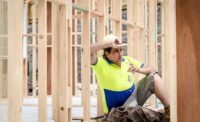In the absence of federal standards to protect highway workers, an industry workgroup is gearing up to produce a voluntary standard that will provide contractors with some guidelines for ensuring that highway workers are safe.
A technical review committee for the American National Standards Institute (ANSI) A10 Committee is currently reviewing a draft standard developed by a workgroup that includes representatives from labor, industry, and the government. Once the technical review committee releases the document, ballots will be sent out for a vote by the full ANSI A(10) committee.
“When there is a lack of regulation on the federal level, people can rely on the ANSI as a voluntary standard to give them guidance as to what they should be doing,” says Scott Schneider, director of occupational safety and health for the Laborers’ Health and Safety Fund of North America (LHSFA), which chairs the workgroup that developed the standard.
In the works since 2005, the standard will address such issues as “positive” protection for workers—when to put up concrete barriers—as well as night work and illumination, equipment operator safety, personal protective equipment and traffic control measures.
Schneider says he does not think the proposal will be controversial. “I think there will be some things that people disagree on,” he says, but he notes that numerous people and organizations involved in highway work zone safety issues—including ARTBA, the American Association of State Highway and Transportation Officials, and the New York State Dept. of Transportation—have already been involved in some way with the development of the proposal. “Everybody’s reviewed it, and a lot of people had input, and I think we’ve come to some pretty good consensus about what ought to be in there,” he says.
But some employer groups are wary. Brad Sant, ARTBA’s vice president of safety and education, says, “It is good to get the information out there and to show the best practices�and it can be done more quickly than a government regulation can be done.” On the other hand, he says, even if the standard explicitly states it is only a voluntary measure meant to illustrate industry best practices, potential legal liabilities can arise. “You’ve just created a gotcha for something that is relatively new and may not be all that well understood by the industry.”
But both Sant and Schneider agree that they do not expect to see the same level of controversy over the highway work zone proposal as seen with the musculoskeletal standard for construction, vigorously opposed by employer groups. “What is in the [highway] standard are very good practices,” Sant says.
A coalition of five employer groups, which included the Associated Builders and Contractors, the Associated General Contractors and the Mechanical Contractors Association of America, said the musculoskeletal proposal did not reflect a “consensus” opinion. The ANSI Appeals Board, the highest level within ANSI to consider a withdrawal, July 17 dismissed the employer groups’ most recent appeal.


Post a comment to this article
Report Abusive Comment